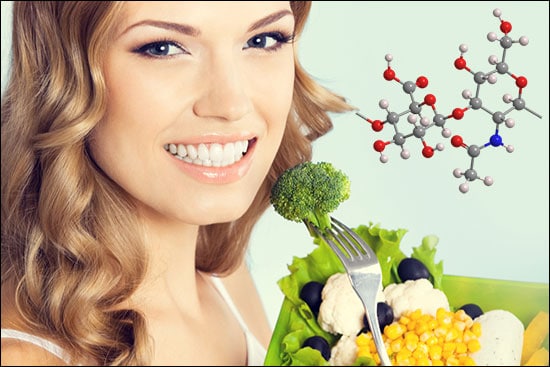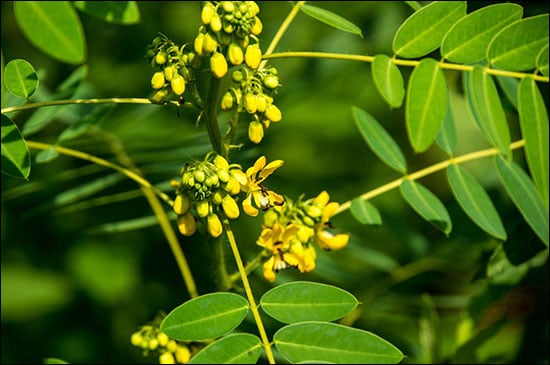Hyaluronic Acid – A Key Molecule in Skin Aging
Hyaluronic acid is a naturally occurring substance in the human body. It occurs at places where connective tissues are present and is also present in the extracellular space in the dermal and epidermal layers of the skin. Due to its gel-like structure and the property of retaining water it is responsible for maintenance of lubrication of the skin and thus it helps the skin look younger and wrinkle-free. It is therefore used in supplements and beauty creams. The extract of Cassia Angustifolia, a medicinal herb, is being recognized as having effects similar to Hyaluronic acid. This article describes what Hyaluronic acid is, what its benefits are, what foods are rich in it and what its ayurvedic version is.
Introduction: What is Hyaluronic Acid?
Hyaluronan also known by the name Hyaluronic Acid, is a naturally occurring acid in all the cells of our body. It is formed in the membrane of each cell and is essential for the growth of all multicellular organisms. It is regularly synthesized and recycled in the body. Since it is a part of the cell that doesn’t reside amongst the main cell organelles, it was not understood as an essential material earlier. But as science progressed it was learnt that Hyaluronic acid has a very, very important role to play in the muscular and skeletal system. Hyaluronic acid is discovered to be an important component of the fluidic membrane that is present between the bone surfaces of joints. This fluidic membrane called the synovial membrane is lubricated with lubricin and Hyaluronic acid to facilitate skeletal movements. Hyaluronic acid is also present in the cartilaginous bones.

Role of Hyaluronic Acid in Skin Health
Apart from skeletal function, the Hyaluronic acid molecules also have important functions in the other connective tissues of the body. Connective tissues are those that support other tissues of the body. The epidermis and the dermis i.e. the first and its inner layers of the skin are also made of dense connective tissue. This is why Hyaluronic acid is crucial in the maintenance and repair of the skin. It is responsible for maintaining the hydration of the skin and also allows the exchange of moisture and sweat. Hyaluronic acid is also being studied to protect the skin from the damaging effect of harsh sun rays, as it hunts and attacks the free radicals that are caused due to one’s exposure to solar rays. Hyaluronic acid helps in healing wounds too.
Therefore, Hyaluronic acid is used in the manufacture of skin and beauty products, such as topical creams, serums, and even eye drops. In the fashion and beauty industry it is used as filler for the inner skin during cosmetic surgeries. It is inserted into the skin via injection by a needle, or a cannula of microscopic size. It is used as filler because it is suitable and doesn’t react with the human body.
Ayurvedic Version of Hyaluronic Acid – Cassia Angustifolia Extract
Indian Senna, botanically known as Cassia Angustifolia, is said to imitate the properties of Hyaluronic acid. The seeds of the cassia Angustifolia plant contain bioactive ingredients that condition the skin because of their high content of polysaccharides which are comparable to Hyaluronic acid molecules in nature and effect.

It also possesses anti-inflammatory properties and provides moisture because it forms a gel like layer on the top when applied externally over skin as well as hair. Therefore it retains the natural moisture of the skin and hair. It is also antimicrobial in nature and prevents oxidation related to aging. It is extensively used in the manufacture of various products of regular skin care such as sun blocker cream, hand and eye moisturizers and lotions, and make up products such as toners, cleansers, foundations, primers, facial masks and anti-aging creams.
5 Foods Rich in Hyaluronic Acid
Although topical use of Hyaluronic Acid delivers the best results, certain foods can also be effective. It is recommended that a combination of these foods and applicable products shall give the best benefits. The foods listed here can help provide the body with Hyaluronic acid, or at least maintain its level so that there is no loss.
- Bone Broth – Prepared by slow boiling in water the bones found in beef and chicken, this food item contains abundant Hyaluronic acid, thanks to the connective tissue present in its ingredients. Bone broth is a soupy food of which the acidity is regulated due to slow boiling and the soup is left with plenty of amino acids, protein, calcium, potassium and zinc. Many celebrities have said that they use bone broth regularly.
- Green Leafy Vegetables – Green leafy vegetables such as spinach, mustard greens, fennel greens, kale, etc., are rich in minerals that encourage the production of Hyaluronic acid. They are themselves also full of antioxidants, beta carotene, vitamin E and vitamin B, which help the formation and repair of skin cells.
- Sweet Potato – This starchy food has great amounts of minerals that enhance the body’s natural production of Hyaluronic acid. They contain various nutrients beneficial for skin health, such as magnesium, potassium, vitamin C and vitamin A.
- Nuts and Seeds – Brazil nuts, almonds, walnuts, pine nuts, flax seeds, cashew nuts, hemp and Chia seeds, and the like, all contain significant amount of a variety of nutrients that enhance the natural synthesis of Hyaluronan, and thus help achieve a younger looking skin.
- Fruits – Fruits themselves do not contain Hyaluronan but they trigger the production of and prevent the destruction of Hyaluronic acid. This is why a diet rich in fruits is recommended to people struggling with skin appearance problems.
- Broccoli – Broccoli is an excellent combination of skin health boosting minerals and nutrients and as a bonus it possesses properties that prevent the degradation of Hyaluronic acid molecules in the body. It also contains a significant amount of vitamin C that helps collagen production and also increases the moisture in the skin.
- Soy products – Soybeans are really versatile because they can be eaten in so many forms and there are so many different food products obtained from soy. The green soy, edamame, and curds – tofu and tempeh, have great content of plane based estrogens. Estrogen increases the amount of Hyaluronan and helps make the skin firmer and more elastic.
Benefits of Hyaluronic Acid
Hyaluronic acid offers the following benefits too:
- It improves the appearance and texture of the skin, making it look more fresh and soft.
- It speeds up the repair and generation of skin cells due to its fast wound healing properties.
- It reduces inflammation in the facial skin and muscles especially when applied as an under-eye cream.
- It can be massaged as a joint ointment because it prevents the wearing out of the natural lubrication in the joints.
- It can also reduce the severity of heartburn in chronic patients.
- It provides relief from dry eyes and also reduces the appearance of dark under eye circles.
- It maintains the fitness of muscles and the bones and prevents their sagging and degeneration.
- It is a natural compound therefore chances are very less that it would react with the body in an unwanted way.
Conclusion
Hyaluronic acid is used in the form of supplements (capsules) and also as serums and creams for external application on the skin. It is usually safe for most people. It is known for its hydrating benefits on the skin and joints of the body and also for its wound healing properties. But, Hyaluronic acid also relieves pain and inflammation. Indian Senna or Swarna Patri as an ayurvedic alternative for Hyaluronic acid is being considered. It has similar effects on the skin and also has wound healing properties which makes it a medicinal product for people having wounds and ulcers inside the body.



